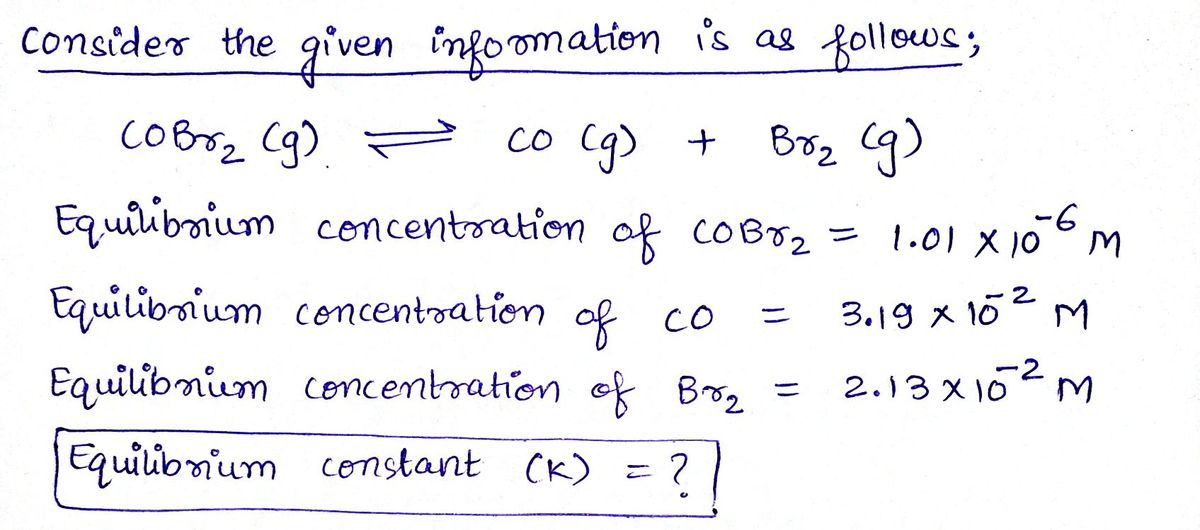[References] Use the References to access important values if needed for this question. Consider the following equilibrium system at 512 K. COBr2 (g) CO(g) + Br₂(g) If an equilibrium mixture of the three gases at 512 K contains 1.01 x 10-6 M COBr2, 3.19 x 10-2 M CO, and 2.13 x 10-2 M Br2, what is the value of the equilibrium constant K? K=
[References] Use the References to access important values if needed for this question. Consider the following equilibrium system at 512 K. COBr2 (g) CO(g) + Br₂(g) If an equilibrium mixture of the three gases at 512 K contains 1.01 x 10-6 M COBr2, 3.19 x 10-2 M CO, and 2.13 x 10-2 M Br2, what is the value of the equilibrium constant K? K=
Chemistry: Principles and Practice
3rd Edition
ISBN:9780534420123
Author:Daniel L. Reger, Scott R. Goode, David W. Ball, Edward Mercer
Publisher:Daniel L. Reger, Scott R. Goode, David W. Ball, Edward Mercer
Chapter14: Chemical Equilibrium
Section: Chapter Questions
Problem 14.3QE: Describe a nonchemical system that is not in equilibrium, and explain why equilibrium has not been...
Related questions
Question
I am doing a calculation wrong somewhere. It keep getting the wrong answer.
![**Equilibrium Constant Calculation**
Consider the following equilibrium system at 512 K:
\[ \text{COBr}_2 (g) \rightleftharpoons \text{CO} (g) + \text{Br}_2 (g) \]
If an equilibrium mixture of the three gases at 512 K contains:
- \(\text{COBr}_2\): 1.01 x 10⁻⁶ M
- \(\text{CO}\): 3.19 x 10⁻² M
- \(\text{Br}_2\): 2.13 x 10⁻² M
What is the value of the equilibrium constant \(K\)?
\[ K = \boxed{\phantom{00}} \]
You have 1 item attempt remaining.
---
In this exercise, you are asked to calculate the equilibrium constant \(K\) for the given chemical reaction using the concentrations of the reactants and products at equilibrium.](/v2/_next/image?url=https%3A%2F%2Fcontent.bartleby.com%2Fqna-images%2Fquestion%2Fb0ffec19-af41-4c50-af1b-66e883fc2bb8%2Fe0cd99ad-384e-47ef-a43d-055c76f6d9f9%2Fuedtydj_processed.jpeg&w=3840&q=75)
Transcribed Image Text:**Equilibrium Constant Calculation**
Consider the following equilibrium system at 512 K:
\[ \text{COBr}_2 (g) \rightleftharpoons \text{CO} (g) + \text{Br}_2 (g) \]
If an equilibrium mixture of the three gases at 512 K contains:
- \(\text{COBr}_2\): 1.01 x 10⁻⁶ M
- \(\text{CO}\): 3.19 x 10⁻² M
- \(\text{Br}_2\): 2.13 x 10⁻² M
What is the value of the equilibrium constant \(K\)?
\[ K = \boxed{\phantom{00}} \]
You have 1 item attempt remaining.
---
In this exercise, you are asked to calculate the equilibrium constant \(K\) for the given chemical reaction using the concentrations of the reactants and products at equilibrium.
Expert Solution
Step 1

Step by step
Solved in 2 steps with 2 images

Knowledge Booster
Learn more about
Need a deep-dive on the concept behind this application? Look no further. Learn more about this topic, chemistry and related others by exploring similar questions and additional content below.Recommended textbooks for you

Chemistry: Principles and Practice
Chemistry
ISBN:
9780534420123
Author:
Daniel L. Reger, Scott R. Goode, David W. Ball, Edward Mercer
Publisher:
Cengage Learning

Introductory Chemistry: A Foundation
Chemistry
ISBN:
9781285199030
Author:
Steven S. Zumdahl, Donald J. DeCoste
Publisher:
Cengage Learning

Chemistry by OpenStax (2015-05-04)
Chemistry
ISBN:
9781938168390
Author:
Klaus Theopold, Richard H Langley, Paul Flowers, William R. Robinson, Mark Blaser
Publisher:
OpenStax

Chemistry: Principles and Practice
Chemistry
ISBN:
9780534420123
Author:
Daniel L. Reger, Scott R. Goode, David W. Ball, Edward Mercer
Publisher:
Cengage Learning

Introductory Chemistry: A Foundation
Chemistry
ISBN:
9781285199030
Author:
Steven S. Zumdahl, Donald J. DeCoste
Publisher:
Cengage Learning

Chemistry by OpenStax (2015-05-04)
Chemistry
ISBN:
9781938168390
Author:
Klaus Theopold, Richard H Langley, Paul Flowers, William R. Robinson, Mark Blaser
Publisher:
OpenStax

Chemistry for Engineering Students
Chemistry
ISBN:
9781337398909
Author:
Lawrence S. Brown, Tom Holme
Publisher:
Cengage Learning

Chemistry: The Molecular Science
Chemistry
ISBN:
9781285199047
Author:
John W. Moore, Conrad L. Stanitski
Publisher:
Cengage Learning

Chemistry & Chemical Reactivity
Chemistry
ISBN:
9781133949640
Author:
John C. Kotz, Paul M. Treichel, John Townsend, David Treichel
Publisher:
Cengage Learning